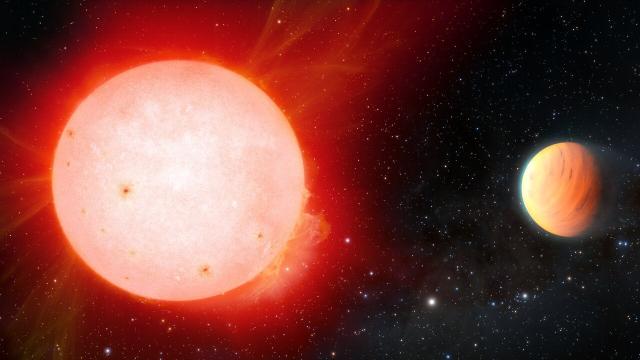Space has no shortage of weird and curious planets. Astronomers using the 3.5-metre telescope at Kitt Peak National Observatory report their discovery of a Jupiter-like world with roughly the same density as a marshmallow, rapidly orbiting a red dwarf star.
The planet is called TOI-3757 b, and it can be found 580 light-years away from Earth in the Auriga constellation. Scientists find exoplanets all the time, but TOI-3757 b is special in that it is the least dense gas giant ever recorded orbiting a red dwarf star. What’s more, TOI-3757 b’s status as a gas giant orbiting a red dwarf is odd, too, as red dwarfs are quite active and can spew flares powerful enough to strip a planet of its atmosphere — and roast it like a s’more, if you will.
“Giant planets around red dwarf stars have traditionally been thought to be hard to form,” Shubham Kanodia, a researcher at Carnegie Institution for Science’s Earth and Planets Laboratory, said in a NOIRLab press release. “So far this has only been looked at with small samples from Doppler surveys, which typically have found giant planets further away from these red dwarf stars. Until now we have not had a large enough sample of planets to find close-in gas planets in a robust manner.”
Kanodia is the lead author of a paper about TOI-3757 b that was published in The Astronomical Journal this past August. NASA’s Transiting Exoplanet Survey Satellite (TESS) first spotted the planet by detecting the dip in brightness of the host star as the world passed in front of it. Kanodia and his team further observed the planet using instruments housed at Kitt Peak’s WIYN 3.5-metre Telescope, along with instruments at Hobby-Eberly Telescope in Texas and the Red Buttes Observatory in Wyoming. Through subsequent analysis, they were able to deduce that TOI-3757 b is approximately 100,000 miles (150,000 kilometers) wide, which is slightly larger than Jupiter. The planet also completes an orbit every 3.5 days.
The big question is why TOI-3757 b is so fluffy. Kanodia and his colleagues suggest that the planet’s rocky core is forming slower than other gas giants due to a lack of heavy elements, which is delaying the accretion of gas particles and keeping the overall density of the planet low. Another possible answer is that Marshmallow World’s orbit appears to be elliptical. During the periods where the planet is closer to the star, excess heat from the red giant may cause the atmosphere to bloat. Whatever the case may be, at the very least we can still enjoy the knowledge of this odd and pleasantly plump exoplanet.
